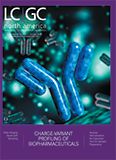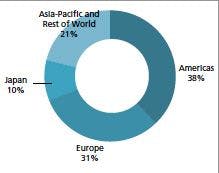How It Works: Ion-Exchange SPE
LCGC North America
The fundamental principles of ion-exchange solid-phase extraction
Ion-exchange media come in both anionic and cationic forms for the extraction of analytes with basic or acidic functional groups. Cation-exchange sorbents contain surface groups that are negatively charged, and the reverse is true for anion-exchange materials. Both surface types interact with the oppositely charged analyte via electrostatic (ionic) interactions. Ion-exchange sorbents can be further classified as either weak or strong exchangers depending on the type of ionic group bonded to the surface. Strong cation exchangers contain an acid functional group, such as a sulfonic acid, which is ionized over the entire pH range. Weak cation exchange sorbents have surface functional groups such as carboxylic acids that are negatively charged at high pH, but neutral at low pH. Strong anion exchangers consist of quaternary ammonium groups that are ionized over the full pH range, and weak anion exchangers have primary, secondary, or tertiary amine moieties that will be ionized at low pH, but neutral at high pH.
It is necessary to prepare the sample so that it exhibits the lowest ionic strength possible and has a pH that results in the analytes being charged-for cation exchange the sample pH should be adjusted to two units below the analyte pKa; this pH adjustment should be performed using the strongest acid or most powerful buffer possible to minimize any increases in ionic strength. For anion-exchange solid-phase extraction (SPE), the pH should be increased two units above the pKa using a suitable base or buffer.
The sorbent must also be in the charged form to retain the analytes; this change to the charged form should be made during the conditioning and equilibration steps. The sorbent bed should be conditioned with a few bed volumes of a water-miscible organic solvent followed by a few bed volumes of pure water. Sorbent equilibration serves two purposes: to convert the sorbent counterion to one that is easily displaced by the analytes and to adjust the pH so that the sorbent groups are charged. The counterion can be exchanged using a salt solution or buffer (the buffer can also be used to adjust the pH). In cation-exchange SPE, the lowest affinity cation is hydrogen and many sorbents can be purchased in the hydrogen form; for anion exchange the lowest affinity ions are fluoride and hydroxide.
Ion-exchange kinetics are slower than those in other SPE modes, therefore, to allow time for analyte–sorbent interaction to take place (thus avoiding analyte breakthrough, which can lead to poor quantitative results) the sample should be loaded at a reduced flow rate. A good starting point is less than 1 mL/min. for a 100-mg sorbent bed.
Wash steps remove undesired contaminant species from the sorbent while leaving the target analytes retained on the sorbent. The ion-exchange retention mechanism is facilitated by low ionic strength buffers, buffers at a pH that retain the charge on the analyte and sorbent, and organic solvents that have little or no effect in the ionic retention mechanism. Any of these will make excellent wash solvents, and washing with 100% organic provides very clean extracts.
Finally, there are three mechanisms for eluting analytes:
1. Using a high ionic strength buffer. The large number of ions within the buffer will disrupt the analyte–sorbent interactions.
2. Altering the pH through addition of an acid or base. This approach can work in two ways: The pH can be adjusted so that the analyte is neutralized and eluted from the SPE sorbent or the functional groups on the surface can be neutralized to similar effect.
3. Using buffers that contain counterions that have a high affinity for the sorbent surface. If the analyte is strongly retained by the surface and the interaction cannot be disrupted by using a high ionic strength buffer, these high-affinity ions can readily displace the analyte, which may have a lower affinity for the sorbent surface. This effect is dramatically more pronounced in anion exchange than in cation exchange.
There are many common situations in which the matrix nature prevents facile use of a particular mechanism-for example, when working with a urine sample. Even if the analyte is ionizable, ion exchange may be an unreliable mechanism choice because of the high or variable salt content in urine, which can compromise analyte retention through competition. These types of samples may require extraction with nonpolar SPE to remove excess ions before the ion-exchange procedure.

Altering Capillary Gas Chromatography Systems Using Silicon Pneumatic Microvalves
May 5th 2025Many multi-column gas chromatography systems use two-position multi-port switching valves, which can suffer from delays in valve switching. Shimadzu researchers aimed to create a new sampling and switching module for these systems.
Studying Cyclodextrins with UHPLC-MS/MS
May 5th 2025Saba Aslani from the University of Texas at Arlington spoke to LCGC International about a collaborative project with Northwestern University, the University of Hong Kong, and BioTools, Inc., investigating mirror-image cyclodextrins using ultra-high performance liquid chromatography–tandem mass spectrometry (UHPLC–MS/MS) and vibrational circular dichroism (VCD).

.png&w=3840&q=75)

.png&w=3840&q=75)



.png&w=3840&q=75)



.png&w=3840&q=75)











